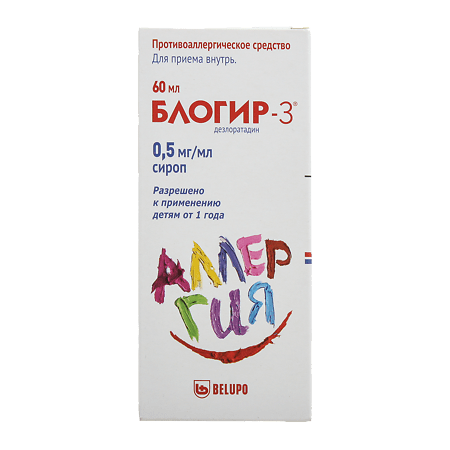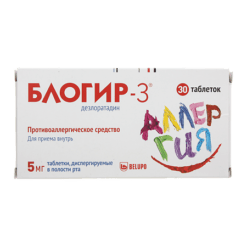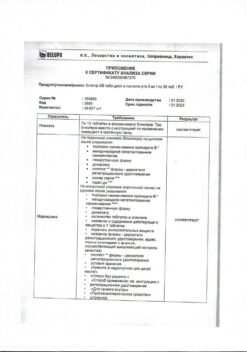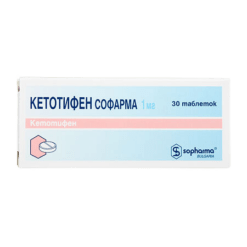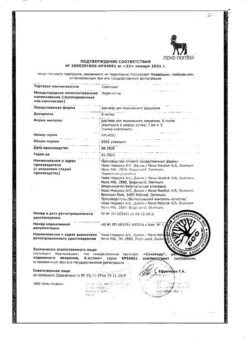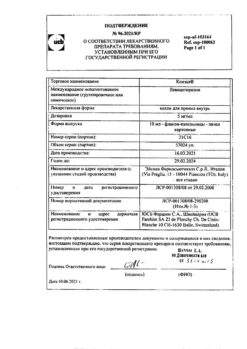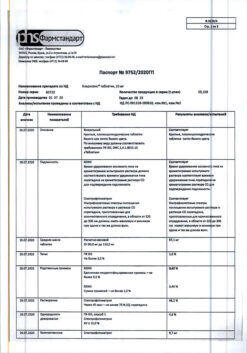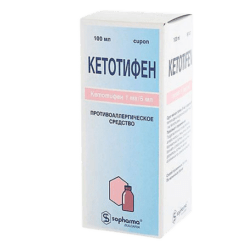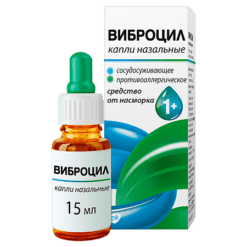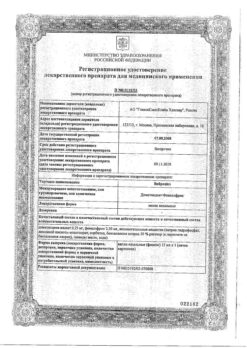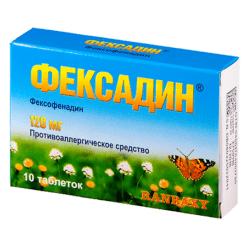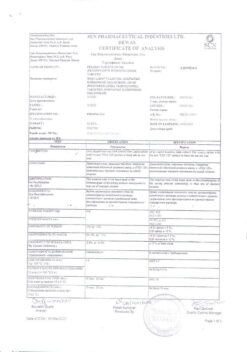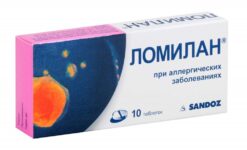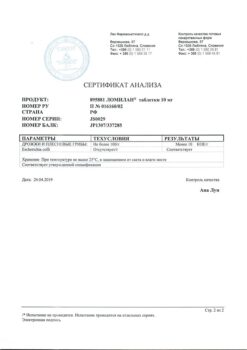No products in the cart.
Description
Pharmacodynamics
A non-sedative long-acting antihistamine. It is the primary active metabolite of loratadine. It selectively blocks the activity of peripheral H1 histamine receptors. Suppresses the release of histamine from mast cells. Inhibits the cascade of allergic inflammatory reactions, including release of anti-inflammatory cytokines, including interleukins IL-4, IL-6, IL-8, IL-13, release of adhesion molecules, such as P-selectin. Thus it prevents and facilitates allergic reactions, has antipruritic and antiexudative effects, decreases capillary permeability, prevents development of edema, spasm of smooth muscles.
The drug has no effect on the central nervous system, practically does not have a sedative effect (does not cause drowsiness) and does not affect psychomotor reactions. It does not cause prolongation of QT interval on ECG.
Pharmacokinetics
Absorption
After oral administration desloratadine is well absorbed in the gastrointestinal tract, determined in blood plasma 30 min after oral administration. Maximal concentration Cmax is reached after about 3 hours.
Distribution
Binding of desloratadine to plasma proteins is 83-87%. When used in adults and adolescents for 14 days at a dose of 5 mg to 20 mg once a day no signs of clinically significant cumulation of desloratadine were found. Simultaneous intake of food or grapefruit juice has no effect on the distribution of desloratadine (when administered at a dose of 7.5 mg once daily). Does not penetrate through the blood-brain barrier.
Metabolism
Subjected to intensive metabolism in the liver by hydroxylation to form 3-ON-desloratadine combined with glucuronide. It is not an inhibitor of CYP3A4 and CYP2D6 isoenzymes and is not a substrate or inhibitor of P-glycoprotein.
Excretion
Desloratadine is excreted as glucuronide compound and in small amount (less than 2%) by kidneys and through intestine (less than 7%) in unchanged form. The elimination half-life T1/2 is on average 27 h.
Indications
Indications
– Allergic rhinitis (elimination or relief of sneezing, nasal congestion, nasal mucus, itching of the nose, itching of the palate, itching and redness of the eyes, watery eyes);
– urticaria (reduction or elimination of skin itching, rash).
Pharmacological effect
Pharmacological effect
Pharmacodynamics
Long-acting non-sedating antihistamine. It is the primary active metabolite of loratadine. Selectively blocks the activity of peripheral H1 histamine receptors. Suppresses the release of histamine from mast cells. Inhibits the cascade of allergic inflammation reactions, including the release of anti-inflammatory cytokines, including interleukins IL-4, IL-6, IL-8, IL-13, and the release of adhesion molecules such as P-selectin. Thus, it prevents the development and facilitates the course of allergic reactions, has antipruritic and antiexudative effects, reduces capillary permeability, prevents the development of tissue edema and smooth muscle spasm.
The drug has no effect on the central nervous system, has virtually no sedative effect (does not cause drowsiness) and does not affect the speed of psychomotor reactions. Does not cause prolongation of the QT interval on the ECG.
Pharmacokinetics
Suction
After oral administration, desloratadine is well absorbed from the gastrointestinal tract and is detected in the blood plasma 30 minutes after oral administration. The maximum concentration Cmax is reached after approximately 3 hours.
Distribution
The binding of desloratadine to plasma proteins is 83-87%. When used in adults and adolescents for 14 days at a dose of 5 mg to 20 mg 1 time per day, no signs of clinically significant accumulation of desloratadine were detected. Simultaneous intake of food or grapefruit juice does not affect the distribution of desloratadine (when taken at a dose of 7.5 mg 1 time per day). Does not penetrate the blood-brain barrier.
Metabolism
It is extensively metabolized in the liver by hydroxylation to form 3-OH-desloratadine combined with a glucuronide. It is not an inhibitor of CYP3A4 and CYP2D6 isoenzymes and is not a substrate or inhibitor of P-glycoprotein.
Removal
Desloratadine is excreted from the body in the form of a glucuronide compound and in a small amount (less than 2%) by the kidneys and through the intestines (less than 7%) unchanged. The half-life T1/2 averages 27 hours.
Special instructions
Special instructions
Use in pediatrics
The effectiveness and safety of using the drug BLOGIR-3® syrup in children under 1 year of age has not been established.
In most cases, rhinitis in children under 2 years of age is infectious in nature. There have been no studies of the effectiveness of desloratadine in rhinitis of infectious etiology.
Differential diagnosis between allergic rhinitis and rhinitis of other origin in children under 2 years of age presents certain difficulties. The differential diagnosis should include consideration of the presence or absence of foci of infection or structural abnormalities of the upper respiratory tract, a thorough history, examination, and appropriate laboratory tests and skin tests.
Impact on the ability to drive vehicles and machinery
At the recommended dose, the drug does not affect the ability to drive vehicles or operate machinery. However, in very rare cases, some patients may experience drowsiness while taking desloratadine, which may affect their ability to drive or operate machinery.
Active ingredient
Active ingredient
Desloratadine
Composition
Composition
1 ml of syrup contains: active substance: desloratadine 0.5 mg.
Excipients: propylene glycol – 150.0 mg, sorbitol – 150.0 mg, hypromellose – 3.5 mg, sucralose – 2.0 mg, sodium citrate – 1.26 mg, tutti-frutti flavor (flavoring substances, propylene glycol E1520) – 0.75 mg, citric acid – 0.5 mg, water – q.s.
Pregnancy
Pregnancy
The use of the drug BLOGIR-3® syrup during pregnancy is contraindicated due to the lack of clinical data on the safety of its use during this period.
Desloratadine is excreted in breast milk, so use of the drug during breastfeeding is contraindicated.
Contraindications
Contraindications
Hypersensitivity to the components of the drug; pregnancy and lactation; age up to 1 year; hereditary disorders of fructose tolerance (due to the presence of sorbitol in the drug).
With caution
Side Effects
Side Effects
During clinical trials in children under 2 years of age, the following adverse events were observed when using the drug, the frequency of which was slightly higher than when using placebo: diarrhea, fever, insomnia; in children aged 2 to 11 years, the incidence of side effects was the same as with placebo; in adults and adolescents over 12 years of age, the following adverse events were observed when using the drug, the frequency of which was slightly higher than when using placebo: increased fatigue, dry mouth, headache.
The following side effects have been reported very rarely:
Interaction
Interaction
Interactions with repeated combined use of desloratadine with ketoconazole, erythromycin, azithromycin, fluoxetine and cimetidine did not reveal clinically significant changes in the concentration of desloratadine in plasma. BLOGIR-3® does not enhance the effect of alcohol on the central nervous system.
Eating does not affect the effectiveness of the drug.
Overdose
Overdose
In clinical studies, no clinically significant adverse effects were observed with desloratadine at doses up to 45 mg (9 times the therapeutic dose).
Treatment: In case of overdose, take standard measures aimed at removing the active substance from the gastrointestinal tract. Symptomatic and supportive therapy is recommended.
Desloratadine is not eliminated by hemodialysis; the effectiveness of peritoneal dialysis has not been established.
Storage conditions
Storage conditions
Store at a temperature not exceeding 25 °C.
Keep out of the reach of children!
Shelf life
Shelf life
3 years.
Manufacturer
Manufacturer
Famar A.V.E., Greece
Additional information
| Shelf life | 3 years. |
|---|---|
| Conditions of storage | Store at a temperature not exceeding 25 °C. Store out of the reach of children! |
| Manufacturer | Bayer Bitterfeld GmbH, Germany |
| Medication form | oral solution |
| Brand | Bayer Bitterfeld GmbH |
Other forms…
Related products
Buy Blogir-3, 0.5 mg/ml 60 ml with delivery to USA, UK, Europe and over 120 other countries.

